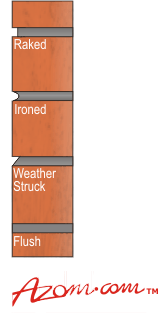May 3 2002
Mortar joints bond bricks together allowing the brickwork to act as a structural element to carry both vertical and lateral loads.
Properly filled and tooled joints improve the durability, weather proofness and sound performance of brickwork. Raked or recessed joints should be avoided in applications where durability is critical, such as saline environments.
NOTES: It is recommended that a raked joint be used for bricks with a bevelled edge.
Colour
It is important to realise that the colour and style of mortar to be used is equally as important as choosing the bricks themselves. Mortar colour and style can dramatically change the overall look of your home/building, so it is important to be aware of the different colours and styles available. Some colours and their basic compositions are outlined in table 1.
Table 1. Approximate mortar compositions based on colour.
|
|
|
Red
|
Yellow
|
Red
|
Natural
|
|
Brown
|
Yellow
|
Brown
|
Natural
|
|
White
|
White bush
|
-
|
White
|
|
Off white
|
White bush
|
-
|
Off white
|
|
Black
|
Yellow
|
Black
|
Natural
|
|
Natural
|
Yellow
|
-
|
Natural
|
|
Cream
|
Yellow
|
-
|
Off white
|
|
Yellow
|
Yellow
|
Yellow
|
Off white
|
Pigmented mortars must be strong enough to retain the pigment particles on the face of the joint. In weak mortars the pigment particles may rapidly be eroded from the face of the joint by wind and rain.
Acid cleaning of brickwork may also degrade pigment colour, leading to faded, patchy and unattractive mortar joints. For durable pigmented mortar always finish the joint by tooling even when a raked joint is required.
Batching Mortar
Unless the proportions of sand, lime and cement that go into a mortar mix are measured with care, it is impossible to be sure if the correct mix has been achieved.
In order to ensure that the correct proportion of materials has been used it is suggested that batching be carried out using buckets. It is unsatisfactory to try and use a shovel to give the same effect, based on the fact that the shovel is able to hold more sand than cement.
Mortar mixes are always specified as the proportion of cement to lime to sand, and always in that order. A common mortar made from portland cement has one part cement to one part lime and 6 parts of sand (abbreviated to C1: L1:S6 or more simply 1:1:6).
The Addition of Lime to Mortar
The addition of lime to mortar has the advantage of making the mortar workable in the wet state and may eliminate the need for plasticiser admixtures.
Mortar containing lime will be less pervious, more durable and more ‘forgiving’ than a mortar without lime.
Other Mortar Additives
In Australia, additives that can be used in mortar compositions are governed by AS 3700 - 1998 Masonry Structures. Approved additives include:
• Plasticisers or workability agents, including air entraining agents complying with AS1478
• Cellulose type chemical water thickeners
• Colouring agents complying with BS 1014 (a British standard)
• Set - retarding chemical agents complying with AS1478
• Bonding polymers
Other admixtures may not be used unless tests have demonstrated compliance with requirements of the standard AS3700 - 1998.
Types of Mortar Joints
Shown below are the different styles of mortar joints that can be used.
|

|
|
Figure 1. Different types of mortar joints, arranged in order of durability.
|